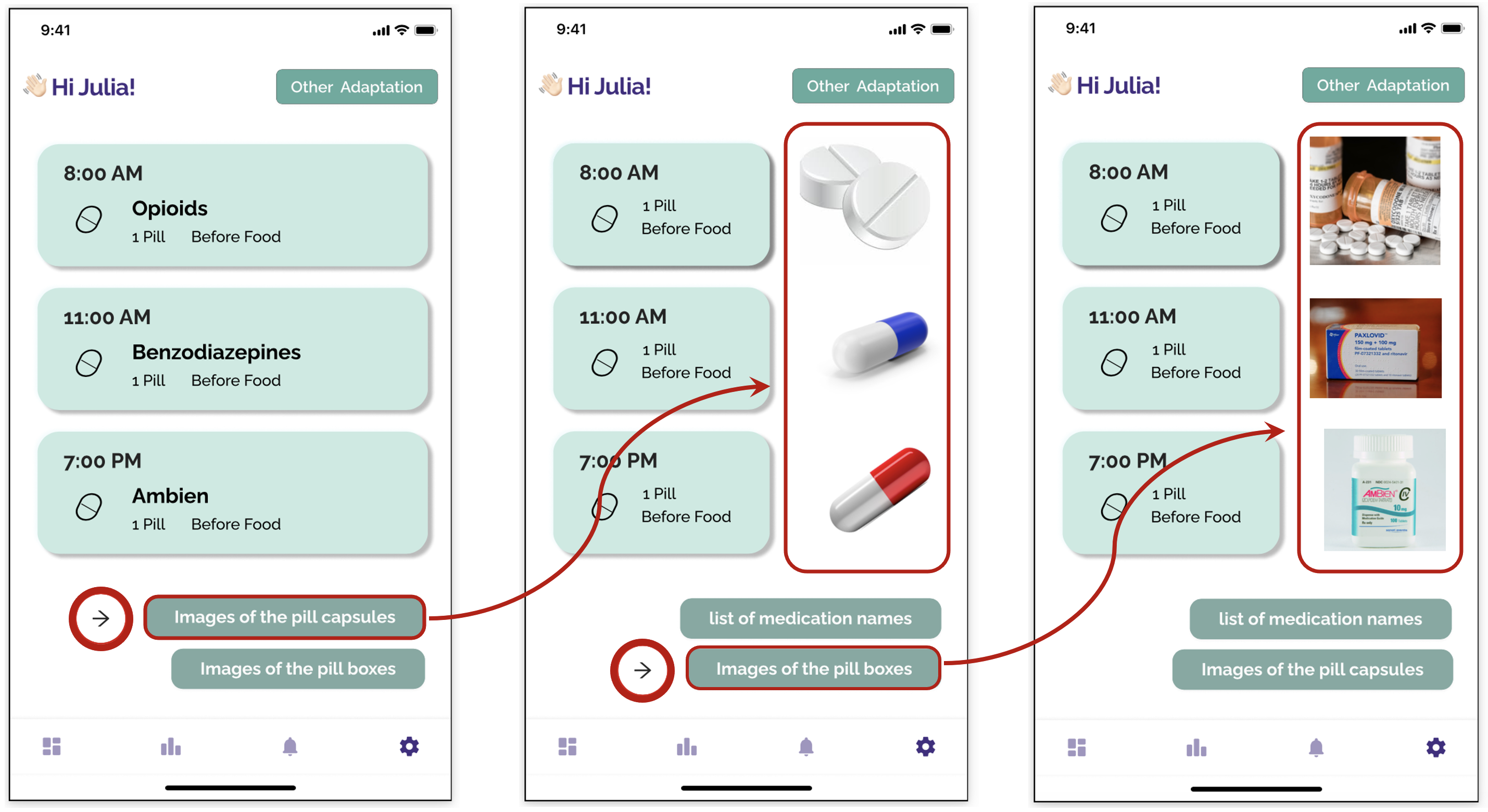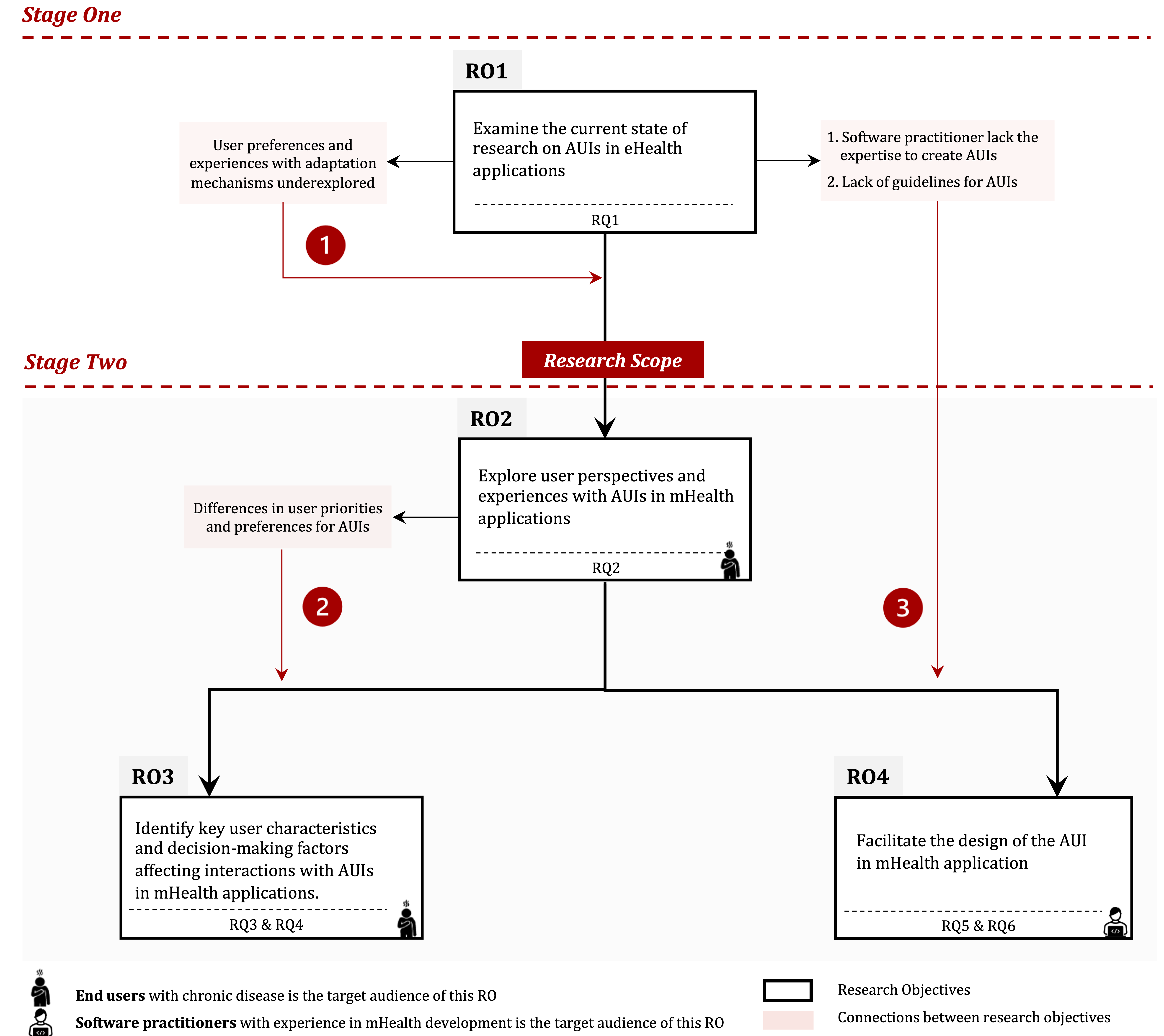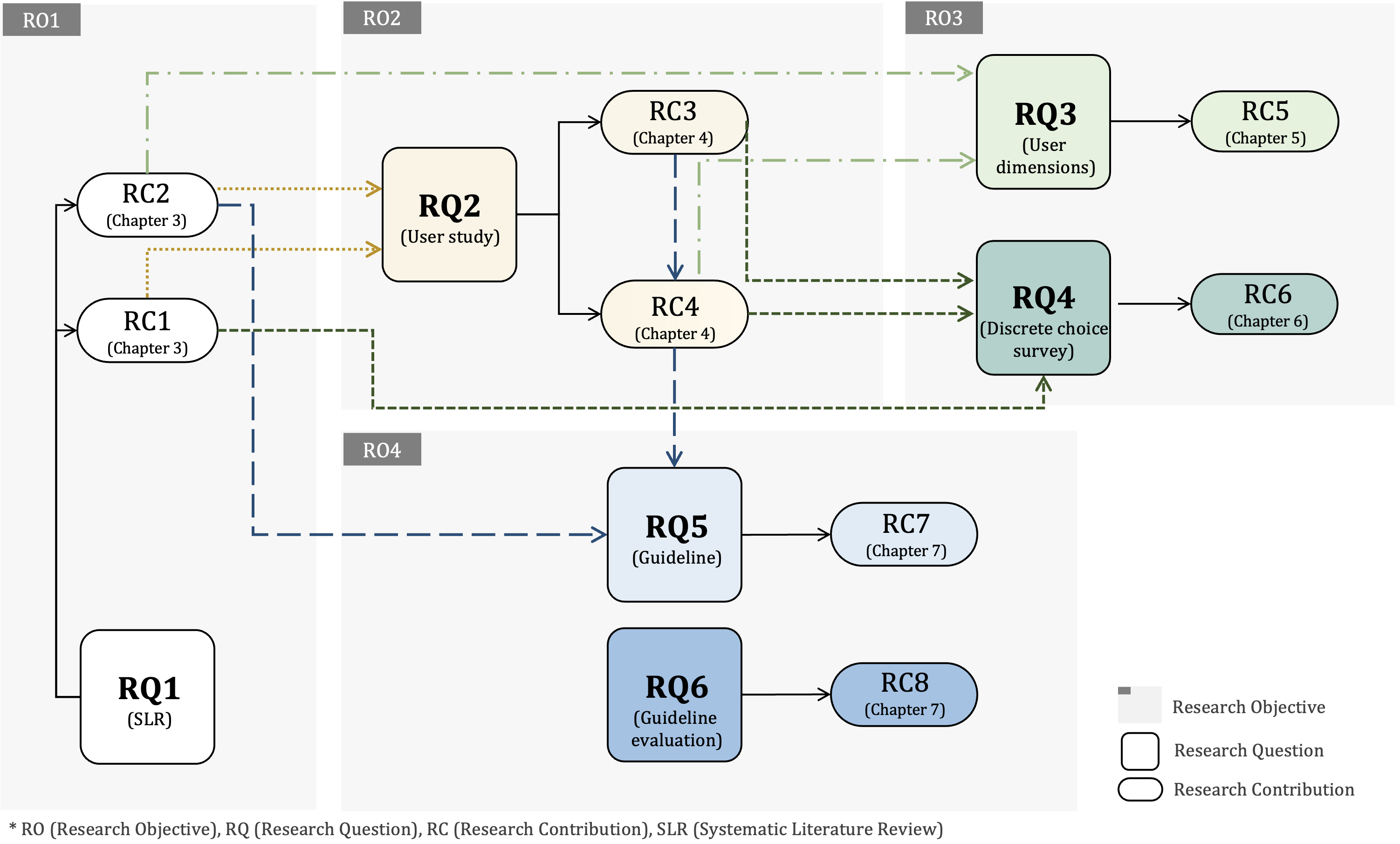Towards Adaptive User Interfaces: mHealth Applications Targeting Chronic Disease
👤 Supervisors
- Prof John Grundy (Main Supervisor)- Monash Univeristy, Melbourne, AU
- Dr Hourieh Khalajzadeh - Deakin Univeristy, Melbourne, AU
- Dr Anuradha Madugalla - Deakin Univeristy, Melbourne, AU
- Dr Humphrey O. Obie - Monash Univeristy, Melbourne, AU
📝 Publications
- ChroniUXMag: A Preliminary Framework for mHealth App Adaptation in Chronic Disease Management
- Development of an Adaptive User Support System Based on Multimodal Large Language Models
- End-Users vs Software Practitioners: Recruitment Challenges and Strategies in Software Engineering Research
- Adaptive User Interfaces for Software Supporting Chronic Disease
- Designing Adaptive User Interfaces for mHealth applications targeting chronic disease: A User-Centric Approach”
- Adaptive user interfaces in systems targeting chronic disease: a systematic literature review
- Towards Adaptive User Interfaces: A Model-Driven Approach for mHealth Applications Targeting Chronic Disease
- Adaptive user interfaces for software supporting chronic diseases
- Leveraging Discrete Choice Experiments for User-Centric Requirements Prioritization in mHealth Applications
🔍 Background

Chronic diseases are long-lasting conditions with persistent effects. Key points include:
- Prevalence: Almost half of Australians were estimated to have one or more chronic diseases in 2020–21.
- Impact: Nearly 9 in 10 deaths in 2021 are associated with chronic diseases.
Characteristics of chronic diseases:
- Highly heterogeneous, affecting patients differently.
- Phases of chronic disease change over time, often including multimorbidity.
- Typically long-lasting and span a person’s lifetime.
- Involves diverse backgrounds and varying psychological and cognitive traits.
🔍 Motivation
Despite the growing promise of mobile health (mHealth) applications in supporting chronic disease self-management, user engagement remains low — particularly among populations with fluctuating symptoms, limited digital literacy, and accessibility needs. Current mHealth solutions often adopt a one-size-fits-all design, overlooking the lived experiences, psychosocial challenges, and evolving conditions of users. This results in high attrition rates, limited long-term effectiveness, and digital exclusion for those who may benefit the most.
While Adaptive User Interfaces (AUIs) offer potential to improve accessibility and personalization, existing research often neglects the human factors critical to their success — such as user trust, perceived control, and the complexity of chronic disease management. Furthermore, challenges like inconsistent adaptation strategies, limited interdisciplinary collaboration, and a lack of inclusive design frameworks continue to hinder progress.

❓ Research problem
To bridge this gap, this research seeks to answer the following problem:
How can Adaptive User Interfaces (AUIs) be effectively designed to enhance accessibility and personalization in mHealth applications for chronic disease management?
🎯 Research overview
This PhD research addresses the critical challenge of designing Adaptive User Interfaces (AUIs) for mobile health (mHealth) applications that support chronic disease self-management. The study is structured into two main stages across four research objectives (RO1–RO4), moving from foundational understanding to practical solution development.
Stage One – Understanding the Landscape
- Research Objective 1 (RO1): Review the current state of AUIs in eHealth.
- RQ1: What is the current state of the art in applying AUIs within applications designed for chronic disease management?
Refining the research scope. Most existing AUIs adopt rigid, one-size-fits-all approaches and lack patient-centered adaptability. Refined scope to focus on mobile applications for chronic disease patients, excluding health professionals and general wellness users.
- RQ1: What is the current state of the art in applying AUIs within applications designed for chronic disease management?
Stage Two – Empirical Design and Validation
- RO2: Understanding User Experiences
- RQ2: How do users of chronic disease management applications perceive and interact with AUIs?
- RO3: Investigating Individual Differences
- RQ3: What key user characteristics influence decision-making in adaptive mHealth applications?
- RQ4: What trade-offs are users willing to make between different adaptive features?
- RO4: Designing and Evaluating Guidelines
- RQ5: How can we facilitate the process of AUI development and inform the design of AUI in applications for chronic disease management?
- RQ6: How effective are the AUI guidelines in supporting software practitioners and improving the design of real-world mHealth applications?

🔬 RQ1: What is the current state of the art in applying AUIs within applications designed for chronic disease management?
This RQ presents a Systematic Literature Review (SLR) grounded in current empirical evidence and analysis. This RQ introduces a taxonomy categorizing data sources for adaptation, data collection techniques, adaptive strategies, adaptation actors, and adaptive elements in AUIs for chronic disease management applications. Additionally, it identifies key research gaps and outlines researchable issues that can inform future advancements in AUI development and evaluation.
By addressing RQ1, this research narrows the research scope to focus on mHealth applications incorporating AUIs, specifically targeting patients with chronic diseases. The findings of this RQ serve as a foundation for the subsequent RQs.
Publication:
🔬 RQ2: How do users of chronic disease management applications perceive and interact with AUIs?
This RQ presents a qualitative and quantitative investigation into user experience with Adaptive User Interfaces (AUIs) in chronic disease management. A qualitative study—comprising interviews and focus groups—explores how individuals interact with AUIs. Complementing this, a quantitative survey captures user preferences across various dimensions of adaptation.
This RQ identifies four key user challenges encountered during interaction with AUIs, along with a set of user-driven design recommendations for improving usability, personalization, and user control in mHealth applications. These findings provide actionable insights to guide the development of more intuitive and patient-centered AUIs in chronic disease management systems.
Publication:
- Adaptive user interfaces for software supporting chronic diseases
- Adaptive User Interfaces for Software Supporting Chronic Disease
🔬 RQ3: What key user characteristics influence decision-making in adaptive mHealth applications?
This RQ investigates how user-specific factors shape adaptation preferences in mHealth applications for chronic disease management. Building upon the persona-based approach of GenderMag, a multi-method study integrates both qualitative and quantitative data. A persona taxonomy—ChroniUXMag—is introduced, identifying six user dimensions that influence adaptation needs: health situation, health attitude, cultural differences, level of dependency, user involvement, and trust in mHealth applications.
This study contributes a structured framework that translates user diversity into actionable design requirements, supporting the creation of user-centered AUIs in chronic disease management.
Publication:
🔬 RQ4: What trade-offs are users willing to make between different adaptive features?
A Discrete Choice Experiment (DCE) was conducted with 186 individuals managing chronic diseases who use mHealth applications. DCEs are a widely recognized method for quantifying preferences and setting priorities in healthcare, helping researchers understand which attributes users value most and what trade-offs they are willing to make. In this study, participants selected preferred adaptation designs from choices that varied across six attributes.
By applying a data-driven approach, this study identifies critical design trade-offs and uncovers preference heterogeneity across diverse user segments—providing essential insights for designing effective, user-centered AUIs in mHealth.
Publication:
🔬 RQ5 and RQ6
This two RQ introduces a structured process for designing and validating Adaptive User Interface (AUI) guidelines, specifically tailored for mHealth applications used in chronic disease management. The guidelines were developed through a two-stage methodology: an initial user study informing early recommendations, followed by refinement through surveys with end users and validation by software practitioners. To assess real-world relevance, a case study involving four commercial mHealth apps was conducted.
By addressing RQ5 and RQ6, this research contributes a validated set of design guidelines that support usability, accessibility, and long-term engagement. These findings inform the development of user-centered AUIs and serve as a key component in advancing adaptive mHealth systems for chronic disease self-management.
Publication:
🧠 Summary of key research contributions
My PhD research focused on designing Adaptive User Interfaces (AUIs) for mobile health (mHealth) applications to support chronic disease self-management. Through a combination of systematic review, empirical studies, and design validation, the following eight key contributions were made: 
RC1 – AUI Taxonomy for Chronic Disease Management
Developed a comprehensive taxonomy outlining core components of AUIs in healthcare, including adaptation data sources, collection methods, interface elements, system actors, and adaptation strategies.
RC2 – Research Gaps and Future Directions
Identified a set of researchable issues critical to understanding user needs, personalization strategies, and evaluation challenges in AUIs.
RC3 – User Perceptions of AUIs
Conducted mixed-method investigations (surveys, interviews, focus groups) with people living with chronic diseases to explore how they perceive and engage with adaptive features.
RC4 – Design Challenges and Practical Trade-Offs
Identified design tensions such as usability vs. control, personalization vs. consistency, and flexibility vs. simplicity. Provided practical design recommendations and critical trade-offs that inform more responsible, user-centered AUI design in mHealth contexts.
RC5 – ChroniUXMag: A User Requirements Framework
Introduced a structured six-dimension user model tailored to people with chronic conditions.
RC6 – Prioritizing Adaptation via Trade-Off Modeling
Quantified what users value most in adaptive features and where they’re willing to compromise. This approach offers a data-driven method for prioritizing features that align with users’ lived realities.
RC7 – Evidence-Based AUI Design Guidelines
Synthesized insights into a set of actionable AUI guidelines that promote user trust, accessibility, and engagement. The guidelines address when and how to implement specific adaptations, with practical examples and decision-support tools for mHealth designers.
RC8 – Real-World Validation with End Users & Practitioners
Validated the proposed guidelines through user, and assessments of four real-world mHealth applications.
Together, these contributions form a systematic and user-centered foundation for future AUI research and practice in health technology. They bridge theory and real-world needs, empowering the design of inclusive, adaptive, and accessible tools that align with the complex lives of people managing chronic conditions.
🔚 Final Remarks
This research set out to tackle a central challenge in digital health: how can we design mobile health (mHealth) applications that adapt to the diverse and evolving needs of people managing chronic diseases?
While mHealth holds great promise, many tools fail to engage users long-term due to one-size-fits-all designs. This thesis explored how Adaptive User Interfaces (AUIs) can enhance personalization, accessibility, and sustained engagement in self-management tools.
Through a structured approach—spanning literature reviews, empirical user studies, choice experiments, and real-world validations—this work advanced the understanding of user-centered adaptation in mHealth.
Ultimately, this research moves the field beyond technical optimization, offering a roadmap for creating more inclusive, personalized, and effective mHealth applications. It lays a strong foundation for future innovation at the intersection of digital health, accessibility, and software engineering.
